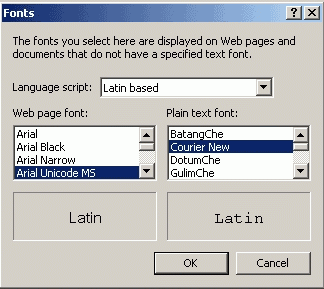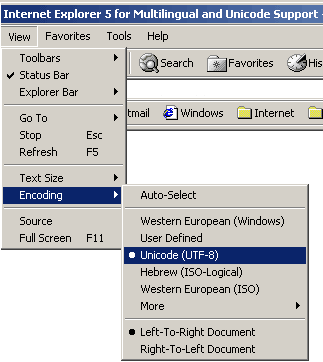Third, click the mouse on Fonts. In the beginning, it
may be best to select Arial Unicode MS font because it can
display a wide range of Unicode fonts. However, you may
find that Times New Roman has a more pleasing font face.

Encoding Selection: Next, it is necessary to select
an encoding scheme that includes the Arabic Unicode number
range. However, Unicode(UTF-8) should be satisfactory for most
purposes, including Arabic Unicode text.
First, click the mouse on View .

Second, click the mouse on Encoding. Third, click the
mouse on Unicode (UTF-8) and deselect Auto-Select.
Deselecting Auto-Select assures that Internet Explorer will
use Unicode encoding each time the program is reloaded.

Finally, click the mouse on Refresh to activate the new
settings.

After Internet Explorer has a Unicode compatible font, and
the Encoding is set to Unicode, Arabic fonts should display
properly.
Test settings: There are a couple of
sites that have Unicode font pages. The Unicode decimal
number range for Arabic is 1536-1791,
64336-65023,
and 65136-65279.
If Internet Explorer has been properly configured, the Arabic
fonts should display properly.
Another web site has an excellent chart of the decimal
number ranges of Unicode. The 1001-2000
, 64001-64999
, and 65001-65536
Hopefully, these comments and pictures will provide you
with enough information so that you will be able to view
Arabic Unicode text. A similar procedure is followed to
display Greek and Hebrew Unicode characters. First
select a Unicode font and then select the appropriate Encoding
scheme. Finally, test the settings by viewing a page
that has the appropriate decimal number for the Unicode
language fonts.
Normal settings: To return to your normal
settings, select the Western European (Windows) encoding
scheme, activate the Auto-Select for Encoding, and
select the font of your choice. However, if you
have chosen a Unicode font that can display all of the
languages that you plan to view, you can leave your browser's
configuration set to view Unicode fonts.
There is additional help for Internet Explorer users at Allan
Wood's site.
If there are difficulties with these browser and email
configurations suggestions, please let me know. I have
not been able to do many tests.
Last edited 06-08-2000
